Leveraging Spectral Clustering and Long Short-Term Memory Techniques for Green Hotel Recommendations in Saudi Arabia
Abstract
1. Introduction
- The author integrated multi-criteria ratings into CF algorithms to address domain-specific challenges in recommending green hotels in Saudi Arabia.
- Text mining and LSTM are utilized by combining LDA for identifying user preferences from user-generated content and LSTM for numerical rating predictions to enhance recommendation accuracy.
- Spectral clustering has been employed to overcome scalability issues in handling large datasets, enabling efficient and effective user segmentation for green hotel recommendations.
2. Recommendation Systems in Tourism and Hospitality
3. Proposed Method
3.1. LDA
| Algorithm 1. LDA Procedure [46] |
| 1 For each topic : (a) Sample from a Dirichlet distribution with parameter . 2 For each document in a corpus : (a) Sample the number of words from a Poisson distribution with mean . (b) Sample from a Dirichlet distribution with parameter . (c) For each word in : i. Draw a topic assignment ii. Draw a word |
3.2. LSTM
3.3. Partition Data Using Spectral Clustering
| Algorithm 2. Clustering Data Using Spectral Clustering |
|
4. Method Evaluation
5. Discussion, Limitations, and Future Work
6. Conclusions
Funding
Institutional Review Board Statement
Informed Consent Statement
Data Availability Statement
Conflicts of Interest
Appendix A
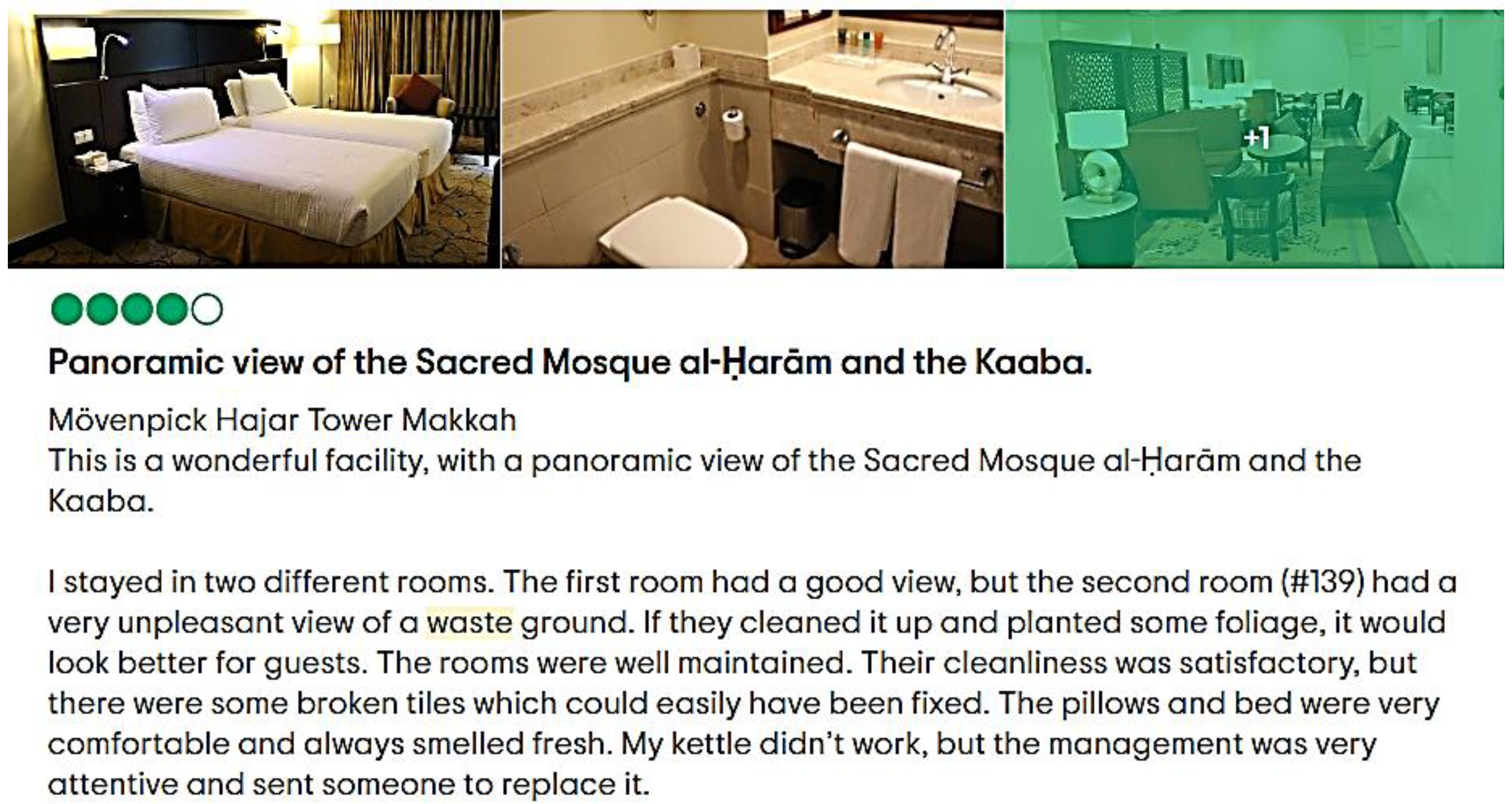

Appendix B
| Axis | Eigenvalue | Difference | Proportion (%) | Cumulative (%) |
|---|---|---|---|---|
| 1 | 1.107309 | 0.081368 | 18.46% | 18.46% |
| 2 | 1.025941 | 0.032887 | 17.10% | 35.55% |
| 3 | 0.993054 | 0.012118 | 16.55% | 52.11% |
| 4 | 0.980935 | 0.024528 | 16.35% | 68.45% |
| 5 | 0.956407 | 0.020053 | 15.94% | 84.39% |
| 6 | 0.936354 | - | 15.61% | 100.00% |
| Tot. | 6.000000 | - | - | - |
| Attribute | Mean | Std-dev | Axis_1 | Axis_2 | Axis_3 | Axis_4 | Axis_5 |
|---|---|---|---|---|---|---|---|
| Location | 3.4672105 | 1.0411018 | 0.3198855 | −0.1585517 | −0.7374386 | 0.5151716 | 0.2481270 |
| Rooms | 3.5535772 | 1.0231504 | 0.4036334 | −0.4168675 | 0.4823920 | 0.3933022 | −0.0821824 |
| Value | 3.4477134 | 1.0415371 | 0.4768978 | 0.1217295 | −0.3576557 | −0.5008108 | −0.4995153 |
| Cleanliness | 3.5021319 | 1.0278193 | 0.2762135 | 0.6926012 | 0.1373064 | −0.0116997 | 0.5716770 |
| Service | 3.4873868 | 1.0518687 | 0.5302816 | 0.2879291 | 0.2617903 | 0.2299057 | −0.3081530 |
| Sleep Quality | 3.4974490 | 1.0544505 | 0.3870780 | −0.4729326 | 0.0904292 | −0.5254585 | 0.5102849 |
References
- Bag, S.; Ghadge, A.; Tiwari, M.K. An integrated recommender system for improved accuracy and aggregate diversity. Comput. Ind. Eng. 2019, 130, 187–197. [Google Scholar] [CrossRef]
- Zhao, Z.; Fan, W.; Li, J.; Liu, Y.; Mei, X.; Wang, Y.; Wen, Z.; Wang, F.; Zhao, X.; Tang, J.; et al. Recommender systems in the era of large language models (llms). IEEE Trans. Knowl. Data Eng. 2024, 36, 6889–6907. [Google Scholar] [CrossRef]
- Moawad, A.; Li, Z.; Pancorbo, I.; Gurumurthy, K.M.; Freyermuth, V.; Islam, E.; Vijayagopal, R.; Stinson, M.; Rousseau, A. A real-time energy and cost efficient vehicle route assignment neural recommender system. Expert Syst. Appl. 2025, 263, 125634. [Google Scholar] [CrossRef]
- Shi, X.; Zhang, Y.; Pujahari, A.; Mishra, S.K. When latent features meet side information: A preference relation based graph neural network for collaborative filtering. Expert Syst. Appl. 2025, 260, 125423. [Google Scholar] [CrossRef]
- Fayyaz, Z.; Ebrahimian, M.; Nawara, D.; Ibrahim, A.; Kashef, R. Recommendation systems: Algorithms, challenges, metrics, and business opportunities. Appl. Sci. 2020, 10, 7748. [Google Scholar] [CrossRef]
- Herlocker, J.L.; Konstan, J.A.; Terveen, L.G.; Riedl, J.T. Evaluating collaborative filtering recommender systems. ACM Trans. Inf. Syst. (TOIS) 2004, 22, 5–53. [Google Scholar] [CrossRef]
- Atas, M.; Felfernig, A.; Polat-Erdeniz, S.; Popescu, A.; Tran, T.N.T.; Uta, M. Towards psychology-aware preference construction in recommender systems: Overview and research issues. J. Intell. Inf. Syst. 2021, 57, 467–489. [Google Scholar] [CrossRef]
- Pu, P.; Chen, L.; Hu, R. Evaluating recommender systems from the user’s perspective: Survey of the state of the art. User Model. User-Adapt. Interact. 2012, 22, 317–355. [Google Scholar] [CrossRef]
- Maslowska, E.; Malthouse, E.C.; Hollebeek, L.D. The role of recommender systems in fostering consumers’ long-term platform engagement. J. Serv. Manag. 2022, 33, 721–732. [Google Scholar] [CrossRef]
- Ahammad, S.H.; Dwarkanath, S.; Joshi, R.; Madhav, B.T.P.; Priya, P.P.; Faragallah, O.S.; Eid, M.M.A.; Rashed, A.N.Z. Social media reviews based hotel recommendation system using collaborative filtering and big data. Multimed. Tools Appl. 2024, 83, 29569–29582. [Google Scholar] [CrossRef]
- Saito, Y.; Yaginuma, S.; Nishino, Y.; Sakata, H.; Nakata, K. Unbiased recommender learning from missing-not-at-random implicit feedback. In Proceedings of the 13th International Conference on Web Search and Data Mining, Houston, TX, USA, 3–7 February 2020; pp. 501–509. [Google Scholar] [CrossRef]
- Afoudi, Y.; Lazaar, M.; Al Achhab, M. Hybrid recommendation system combined content-based filtering and collaborative prediction using artificial neural network. Simul. Model. Pract. Theory 2021, 113, 102375. [Google Scholar] [CrossRef]
- Pantano, E.; Priporas, C.-V.; Stylos, N. ‘You will like it!’using open data to predict tourists’ response to a tourist attraction. Tour. Manag. 2017, 60, 430–438. [Google Scholar] [CrossRef]
- Harris, L.; Dennis, C. Engaging customers on Facebook: Challenges for e-retailers. J. Consum. Behav. 2011, 10, 338–346. [Google Scholar] [CrossRef]
- Li, R.; Li, Y.-Q.; Ruan, W.-Q.; Zhang, S.-N.; Wang, M.-Y. Sentiment mining of online reviews of peer-to-peer accommodations: Customer emotional heterogeneity and its influencing factors. Tour. Manag. 2023, 96, 104704. [Google Scholar] [CrossRef]
- Karabila, I.; Darraz, N.; El-Ansari, A.; Alami, N.; El Mallahi, M. Enhancing collaborative filtering-based recommender system using sentiment analysis. Future Internet 2023, 15, 235. [Google Scholar] [CrossRef]
- Khojamli, H.; Razmara, J. Survey of similarity functions on neighborhood-based collaborative filtering. Expert Syst. Appl. 2021, 185, 115482. [Google Scholar] [CrossRef]
- Alturif, G.; Saleh, W. Attitudes and Behaviour towards More Sustainable Travel Options in the Kingdom of Saudi Arabia: An Emerging Social Change? Sustainability 2023, 15, 12548. [Google Scholar] [CrossRef]
- Altassan, A. Sustainability of heritage villages through eco-tourism investment (case study: Al-Khabra Village, Saudi Arabia). Sustainability 2023, 15, 7172. [Google Scholar] [CrossRef]
- Adomavicius, G.; Kwon, Y. New recommendation techniques for multicriteria rating systems. IEEE Intell. Syst. 2007, 22, 48–55. [Google Scholar] [CrossRef]
- Guan, X.; Li, C.-T.; Guan, Y. Matrix factorization with rating completion: An enhanced SVD model for collaborative filtering recommender systems. IEEE Access 2017, 5, 27668–27678. [Google Scholar] [CrossRef]
- Ormándi, R.; Hegedus, I.; Csernai, K.; Jelasity, M. Towards inferring ratings from user behavior in BitTorrent communities. In Proceedings of the 2010 19th IEEE International Workshops on Enabling Technologies: Infrastructures for Collaborative Enterprises, Larissa, Greece, 28–30 June 2010; pp. 217–222. [Google Scholar] [CrossRef][Green Version]
- Esmaeili, L.; Nasiri, M.; Minaei-Bidgoli, B. Personalizing group recommendation to social network users. In Web Information Systems and Mining, Proceedings of the International Conference, WISM 2011, Taiyuan, China, 24–25 September 2011, Proceedings, Part I; Springer: Berlin/Heidelberg, Germany, 2011; pp. 124–133. [Google Scholar] [CrossRef]
- Shelar, S.; Kamat, P.; Varpe, A.; Birajdar, A. TRAVELMATE travel package recommendation system. Int. Res. J. Eng. Technol. (IRJET) 2018, 5, 4095–4097. [Google Scholar] [CrossRef]
- Jia, Z.; Yang, Y.; Gao, W.; Chen, X. User-based collaborative filtering for tourist attraction recommendations. In Proceedings of the 2015 IEEE International Conference on Computational Intelligence & Communication Technology, Ghaziabad, India, 13–14 February 2015; pp. 22–25. [Google Scholar] [CrossRef]
- Aldayel, M.; Al-Nafjan, A.; Al-Nuwaiser, W.M.; Alrehaili, G.; Alyahya, G. Collaborative Filtering-Based Recommendation Systems for Touristic Businesses, Attractions, and Destinations. Electronics 2023, 12, 4047. [Google Scholar] [CrossRef]
- Lucas, J.P.; Luz, N.; Moreno, M.N.; Anacleto, R.; Figueiredo, A.A.; Martins, C. A hybrid recommendation approach for a tourism system. Expert Syst. Appl. 2013, 40, 3532–3550. [Google Scholar] [CrossRef]
- Chalkiadakis, G.; Ziogas, I.; Koutsmanis, M.; Streviniotis, E.; Panagiotakis, C.; Papadakis, H. A novel hybrid recommender system for the tourism domain. Algorithms 2023, 16, 215. [Google Scholar] [CrossRef]
- Hu, Y.-H.; Tsai, C.-F.; Sun, Y.-C. A novel hotel recommender system incorporating review sentiment and contextual information. Int. J. Data Sci. Anal. 2024, 1–12. [Google Scholar] [CrossRef]
- García-Crespo, A.; Chamizo, J.; Rivera, I.; Mencke, M.; Colomo-Palacios, R.; Gómez-Berbís, J.M. SPETA: Social pervasive e-Tourism advisor. Telemat. Inform. 2009, 26, 306–315. [Google Scholar] [CrossRef]
- Li, C.; Zheng, W. Nipping trouble in the bud: A proactive tourism recommender system. Inf. Manag. 2025, 62, 104062. [Google Scholar] [CrossRef]
- Arif, Y.M.; Putra, D.D.; Wardani, D.; Nugroho, S.M.S.; Hariadi, M. Decentralized recommender system for ambient intelligence of tourism destinations serious game using known and unknown rating approach. Heliyon 2023, 9, e14267. [Google Scholar] [CrossRef] [PubMed]
- Wang, E.; Li, D.; Lan, S.; Li, Y. Personalized Hotel Recommendation Algorithms Based on Online Reviews. In Proceedings of the 2023 IEEE 11th International Conference on Information, Communication and Networks (ICICN), Xi’an, China, 17–20 August 2023; pp. 823–829. [Google Scholar] [CrossRef]
- Nilashi, M.; Bagherifard, K.; Rahmani, M.; Rafe, V. A recommender system for tourism industry using cluster ensemble and prediction machine learning techniques. Comput. Ind. Eng. 2017, 109, 357–368. [Google Scholar] [CrossRef]
- Nilashi, M.; Ahani, A.; Esfahani, M.D.; Yadegaridehkordi, E.; Samad, S.; Ibrahim, O.; Sharef, N.M.; Akbari, E. Preference learning for eco-friendly hotels recommendation: A multi-criteria collaborative filtering approach. J. Clean. Prod. 2019, 215, 767–783. [Google Scholar] [CrossRef]
- Mishra, R.K.; Jothi, J.A.A.; Urolagin, S.; Irani, K. Knowledge based topic retrieval for recommendations and tourism promotions. Int. J. Inf. Manag. Data Insights 2023, 3, 100145. [Google Scholar] [CrossRef]
- Wang, X. Construction of smart tourism system integrating tourist needs and scene characteristics. Syst. Soft Comput. 2024, 6, 200168. [Google Scholar] [CrossRef]
- Gao, J.; Peng, P.; Lu, F.; Claramunt, C.; Xu, Y. Towards travel recommendation interpretability: Disentangling tourist decision-making process via knowledge graph. Inf. Process. Manag. 2023, 60, 103369. [Google Scholar] [CrossRef]
- Ray, B.; Garain, A.; Sarkar, R. An ensemble-based hotel recommender system using sentiment analysis and aspect categorization of hotel reviews. Appl. Soft Comput. 2021, 98, 106935. [Google Scholar] [CrossRef]
- Jiang, R.; Dai, B. Cultural tourism attraction recommendation model based on optimized weighted association rule algorithm. Syst. Soft Comput. 2024, 6, 200094. [Google Scholar] [CrossRef]
- Yang, S.; Li, Q.; Jang, D.; Kim, J. Deep learning mechanism and big data in hospitality and tourism: Developing personalized restaurant recommendation model to customer decision-making. Int. J. Hosp. Manag. 2024, 121, 103803. [Google Scholar] [CrossRef]
- Cui, C.; Wei, M.; Che, L.; Wu, S.; Wang, E. Hotel recommendation algorithms based on online reviews and probabilistic linguistic term sets. Expert Syst. Appl. 2022, 210, 118503. [Google Scholar] [CrossRef]
- Esmaeili, L.; Mardani, S.; Golpayegani, S.A.H.; Madar, Z.Z. A novel tourism recommender system in the context of social commerce. Expert Syst. Appl. 2020, 149, 113301. [Google Scholar] [CrossRef]
- Hong, M.; Jung, J.J. Multi-criteria tensor model for tourism recommender systems. Expert Syst. Appl. 2021, 170, 114537. [Google Scholar] [CrossRef]
- Pérez, J.; Pérez, A.; Casillas, A.; Gojenola, K. Cardiology record multi-label classification using latent Dirichlet allocation. Comput. Methods Programs Biomed. 2018, 164, 111–119. [Google Scholar] [CrossRef]
- Blei, D.M.; Ng, A.Y.; Jordan, M.I. Latent dirichlet allocation. J. Mach. Learn. Res. 2003, 3, 993–1022. [Google Scholar] [CrossRef]
- Jelodar, H.; Wang, Y.; Yuan, C.; Feng, X. Latent Dirichlet allocation (LDA) and topic modeling: Models, applications, a survey. Multimed. Tools Appl. 2019, 78, 15169–15211. [Google Scholar] [CrossRef]
- Yu, D.; Xiang, B. Discovering topics and trends in the field of Artificial Intelligence: Using LDA topic modeling. Expert Syst. Appl. 2023, 225, 120114. [Google Scholar] [CrossRef]
- Kukreja, V. Comic exploration and Insights: Recent trends in LDA-Based recognition studies. Expert Syst. Appl. 2024, 255, 124732. [Google Scholar] [CrossRef]
- Ali, T.; Omar, B.; Soulaimane, K. Analyzing tourism reviews using an LDA topic-based sentiment analysis approach. MethodsX 2022, 9, 101894. [Google Scholar] [CrossRef]
- Wang, W.; Feng, Y.; Dai, W. Topic analysis of online reviews for two competitive products using latent Dirichlet allocation. Electron. Commer. Res. Appl. 2018, 29, 142–156. [Google Scholar] [CrossRef]
- Prieto, A.; Prieto, B.; Ortigosa, E.M.; Ros, E.; Pelayo, F.; Ortega, J.; Rojas, I. Neural networks: An overview of early research, current frameworks and new challenges. Neurocomputing 2016, 214, 242–268. [Google Scholar] [CrossRef]
- Cichy, R.M.; Kaiser, D. Deep neural networks as scientific models. Trends Cogn. Sci. 2019, 23, 305–317. [Google Scholar] [CrossRef]
- Hochreiter, S.; Schmidhuber, J. Long short-term memory. Neural Comput. 1997, 9, 1735–1780. [Google Scholar] [CrossRef] [PubMed]
- Saleh, H.; Amer, E.; Abuhmed, T.; Ali, A.; Al-Fuqaha, A.; El-Sappagh, S. Computer aided progression detection model based on optimized deep LSTM ensemble model and the fusion of multivariate time series data. Sci. Rep. 2023, 13, 16336. [Google Scholar] [CrossRef]
- Xu, D.; Tian, Y. A comprehensive survey of clustering algorithms. Ann. Data Sci. 2015, 2, 165–193. [Google Scholar] [CrossRef]
- Von Luxburg, U. A tutorial on spectral clustering. Stat. Comput. 2007, 17, 395–416. [Google Scholar] [CrossRef]
- Et-Taleby, A.; Boussetta, M.; Benslimane, M. Faults Detection for Photovoltaic Field Based on K-Means, Elbow, and Average Silhouette Techniques through the Segmentation of a Thermal Image. Int. J. Photoenergy 2020, 2020, 6617597. [Google Scholar] [CrossRef]
- Frahling, G.; Sohler, C. A fast k-means implementation using coresets. In Proceedings of the Twenty-Second Annual Symposium on Computational Geometry, Sedona, AZ, USA, 5–7 June 2006; pp. 135–143. [Google Scholar] [CrossRef]
- Adhau, S.; Moharil, R.; Adhau, P. K-Means clustering technique applied to availability of micro hydro power. Sustain. Energy Technol. Assess. 2014, 8, 191–201. [Google Scholar] [CrossRef]
- Das, K.; Kumar, R.; Krishna, A. Analyzing electric vehicle battery health performance using supervised machine learning. Renew. Sustain. Energy Rev. 2024, 189, 113967. [Google Scholar] [CrossRef]
- Hu, Z.; Gao, Y.; Ji, S.; Mae, M.; Imaizumi, T. Improved multistep ahead photovoltaic power prediction model based on LSTM and self-attention with weather forecast data. Appl. Energy 2024, 359, 122709. [Google Scholar] [CrossRef]
- de Oliveira, J.T.; de Carvalho Costa, L.R.; Agnol, G.D.; Féris, L.A. Experimental design and data prediction by Bayesian statistics for adsorption of tetracycline in a GAC fixed-bed column. Sep. Purif. Technol. 2023, 319, 124097. [Google Scholar] [CrossRef]
- Yin, C.-X.; Peng, Q.-K. A careful assessment of recommendation algorithms related to dimension reduction techniques. Knowl.-Based Syst. 2012, 27, 407–423. [Google Scholar] [CrossRef]
- Faraj, T.; Tarawneh, Q.; Oroud, I. The applicability of the tourism climate index in a hot arid environment: Saudi Arabia as a case study. Int. J. Environ. Sci. Technol. 2023, 20, 3849–3860. [Google Scholar] [CrossRef]
- World Travel & Tourism Council, “Saudi Arabia Travel & Tourism Economic Impact Research”, World Travel & Tourism Council, June 2024. Available online: https://researchhub.wttc.org/product/saudi-arabia-economic-impact-report (accessed on 16 February 2025).
- Tabash, M.I.; Farooq, U.; El Refae, G.A.; Al-Faryan, M.A.S.; Athamena, B. Impact of religious tourism on the economic development, energy consumption and environmental degradation: Evidence from the Kingdom of Saudi Arabia. Tour. Rev. 2023, 78, 1004–1018. [Google Scholar] [CrossRef]
- Gössling, S.; Peeters, P. Assessing tourism’s global environmental impact 1900–2050. J. Sustain. Tour. 2015, 23, 639–659. [Google Scholar] [CrossRef]
- Vanhove, N. Tourism policy—Between competitiveness and sustainability: The case of Bruges. Tour. Rev. 2002, 57, 34–40. [Google Scholar] [CrossRef]
- Alegre, J.; Sard, M. When demand drops and prices rise. Tourist packages in the Balearic Islands during the economic crisis. Tour. Manag. 2015, 46, 375–385. [Google Scholar] [CrossRef]
- Lai, L.-h.; Graefe, A.R. Identifying market potential and destination choice factors of Taiwanese overseas travelers. J. Hosp. Leis. Mark. 1999, 6, 45–65. [Google Scholar] [CrossRef]
- Calveras, A. All-inclusive and value creation in hospitality: Evidence from a mature destination, 2001–2017. Tour. Manag. 2019, 74, 234–246. [Google Scholar] [CrossRef]
- Evangelopoulos, N.E. Latent semantic analysis. Wiley Interdiscip. Rev. Cogn. Sci. 2013, 4, 683–692. [Google Scholar] [CrossRef]
- Hinton, G.E. Deep belief networks. Scholarpedia 2009, 4, 5947. [Google Scholar] [CrossRef]
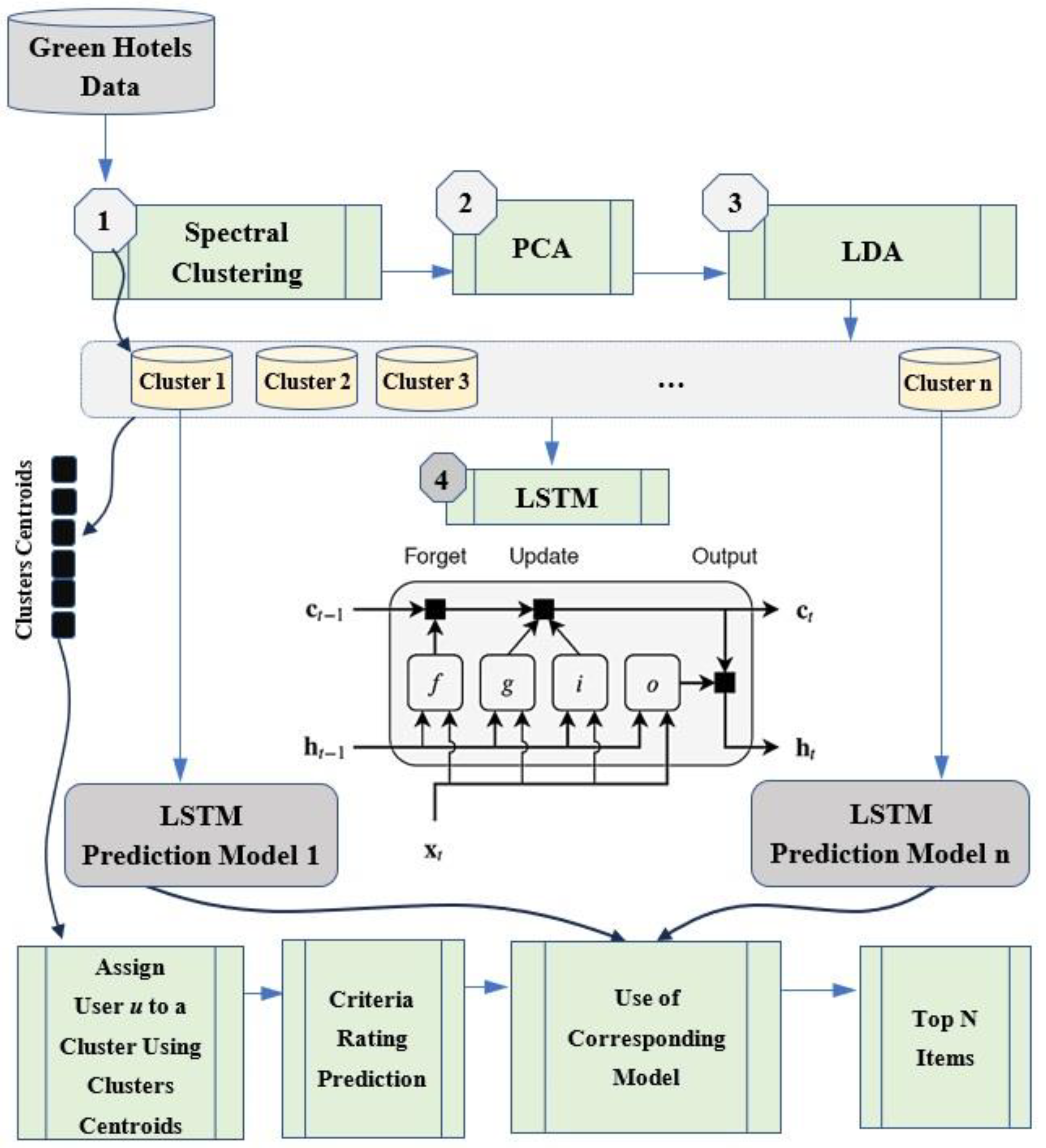
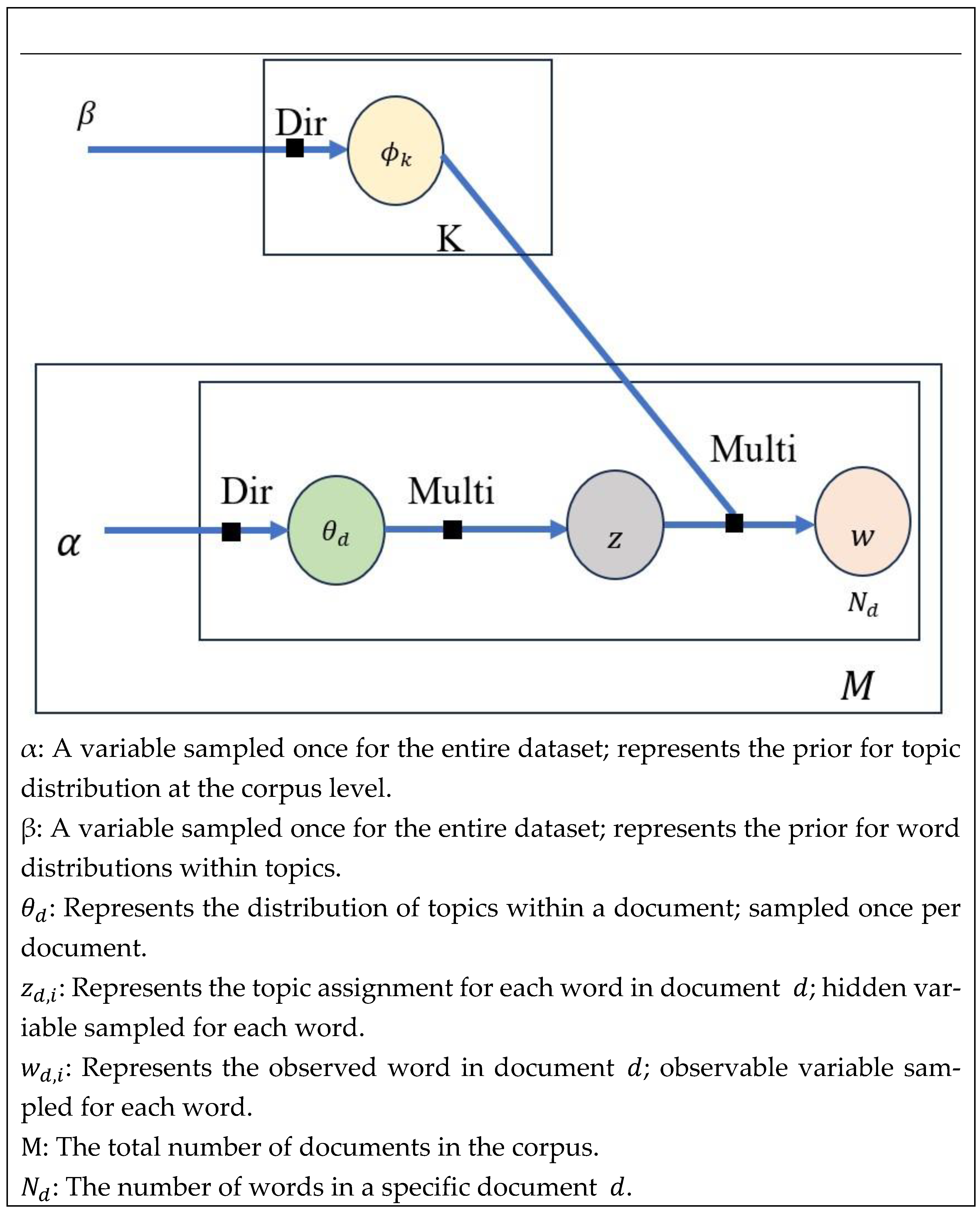
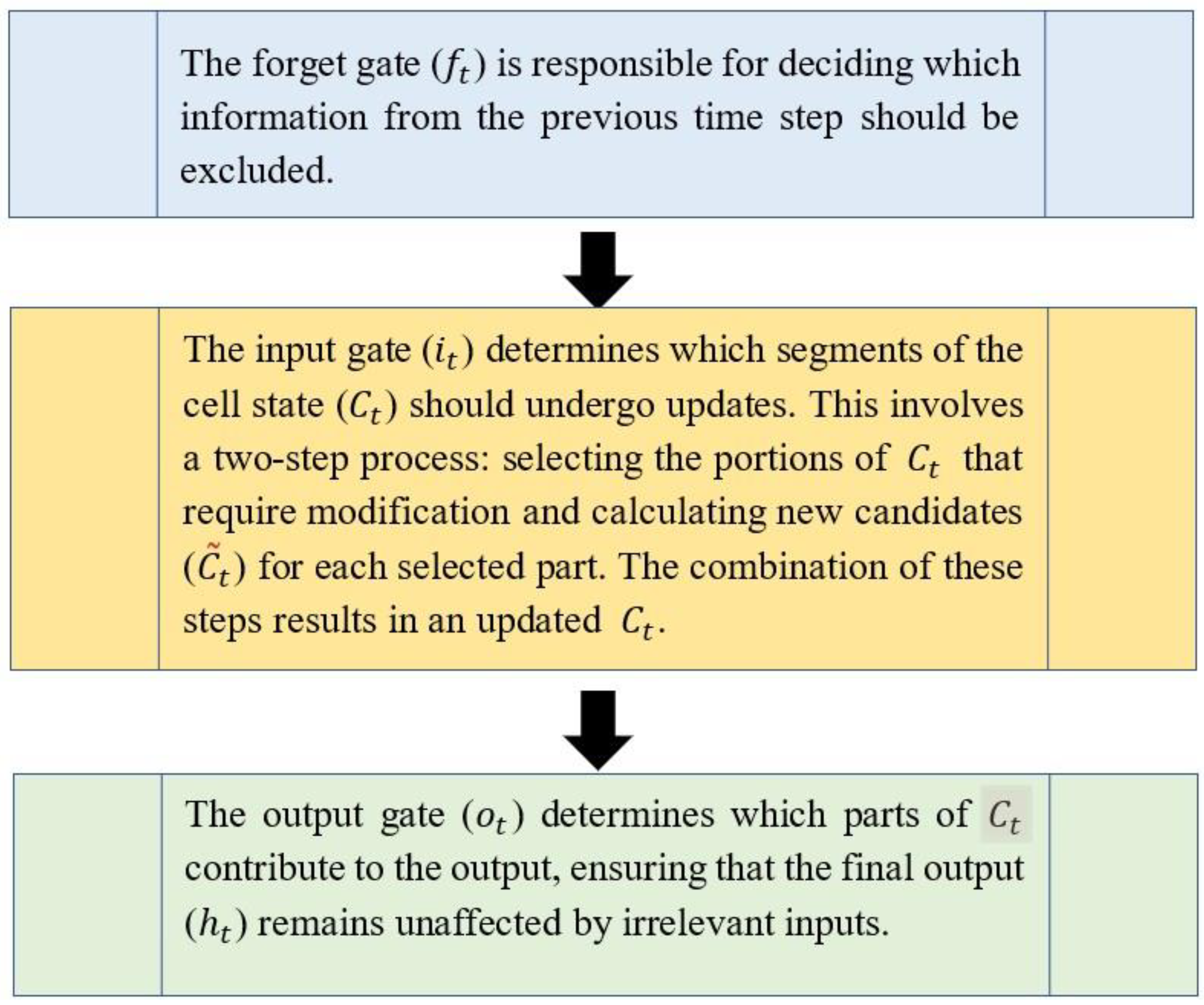
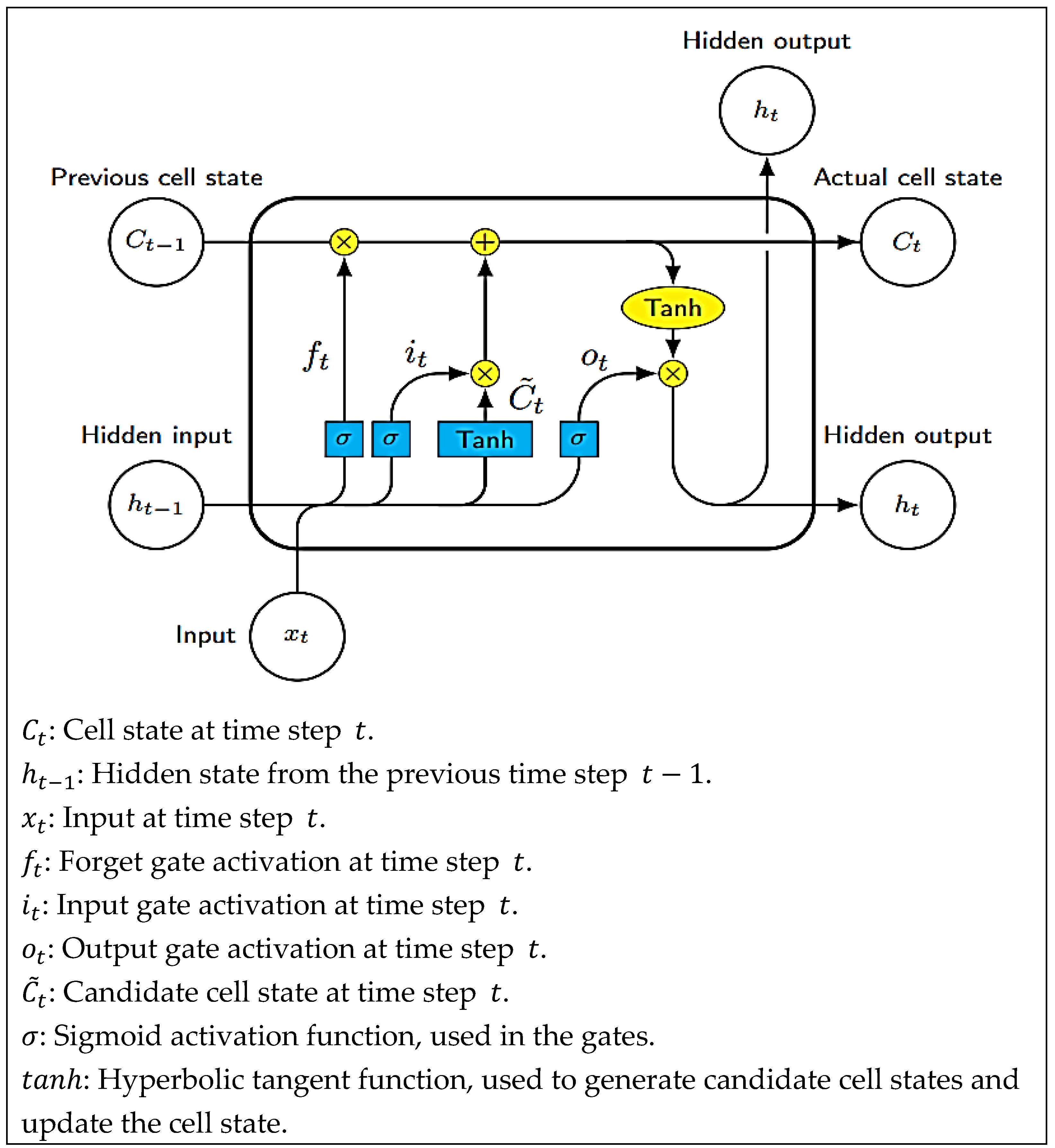
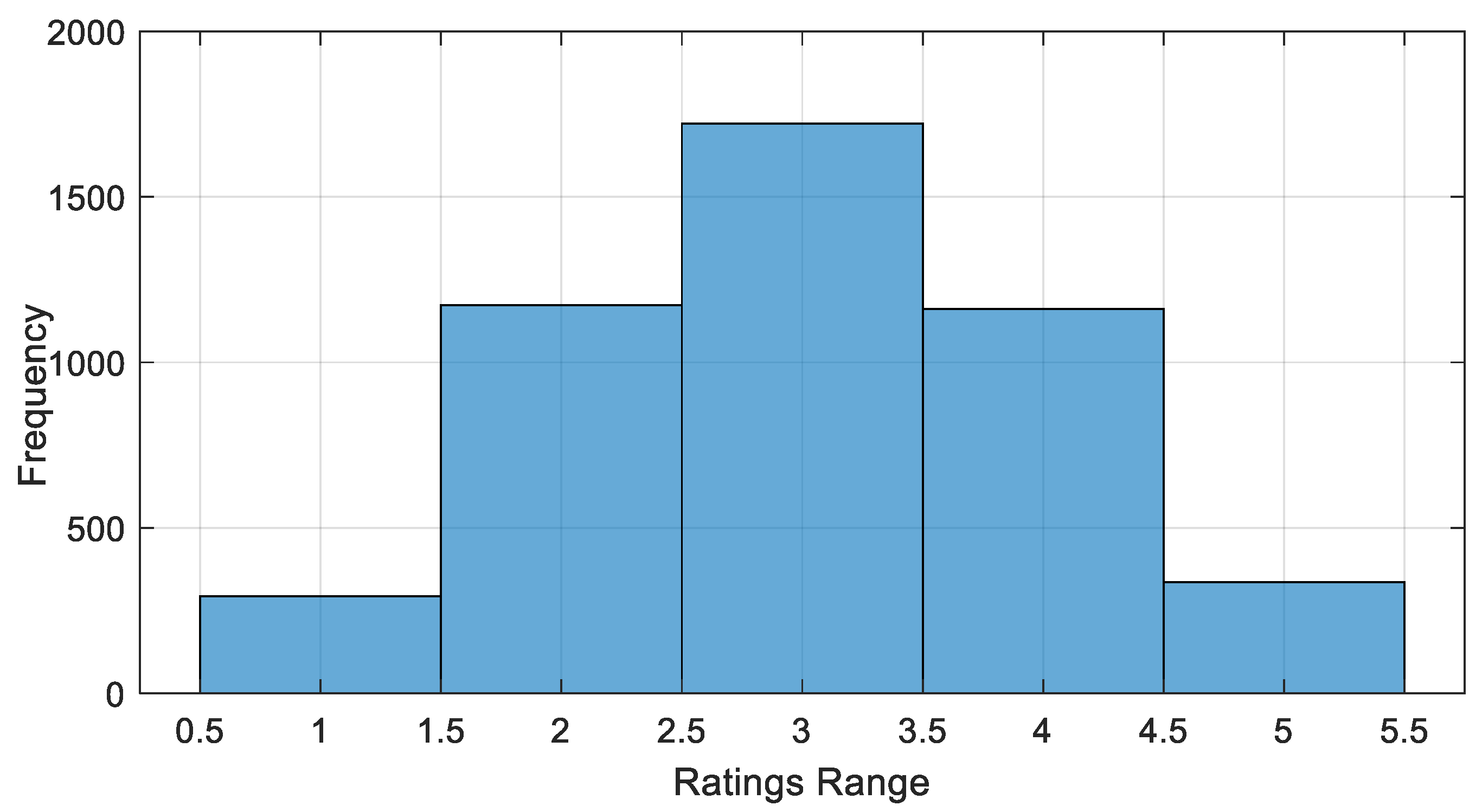
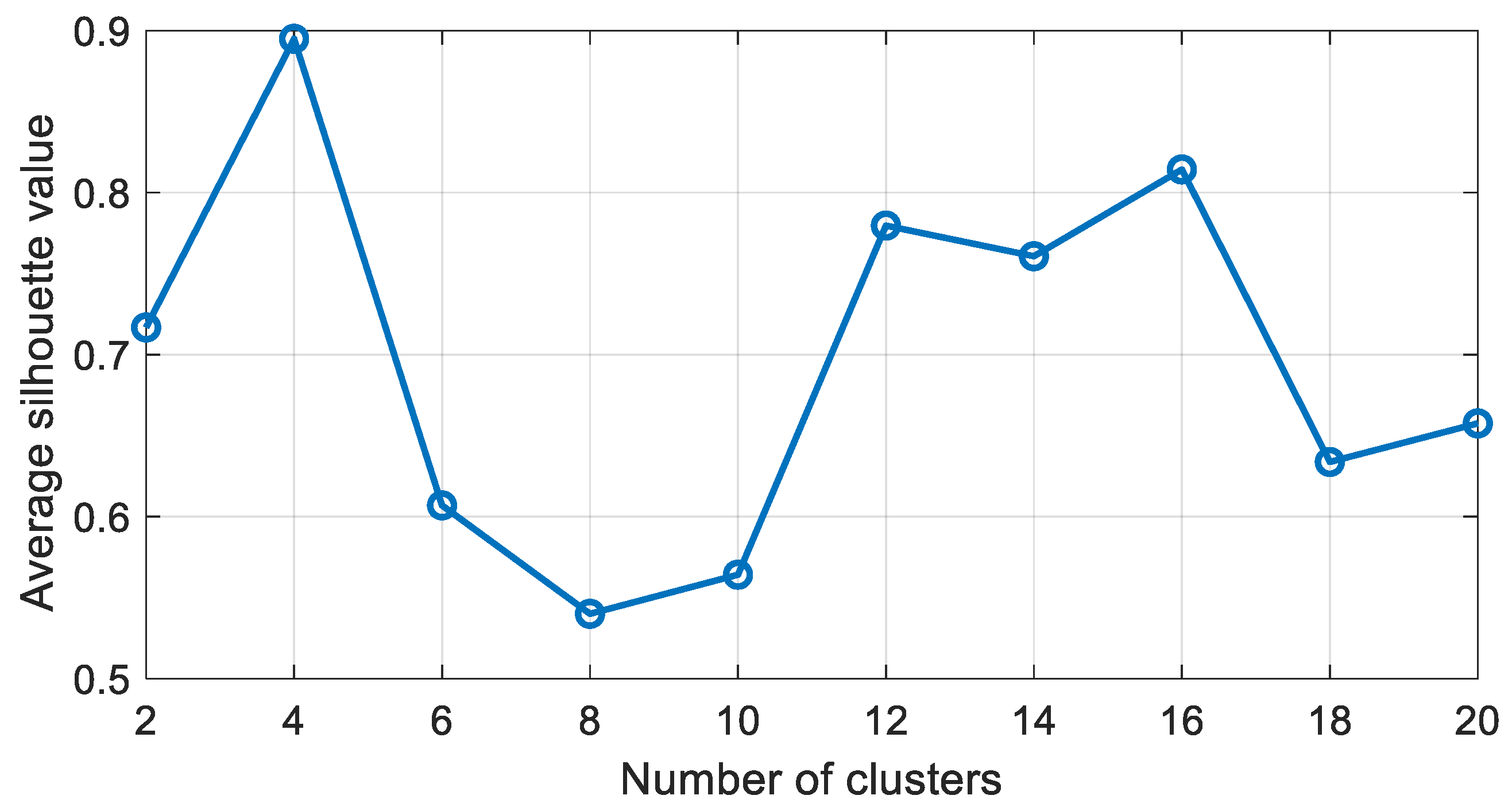


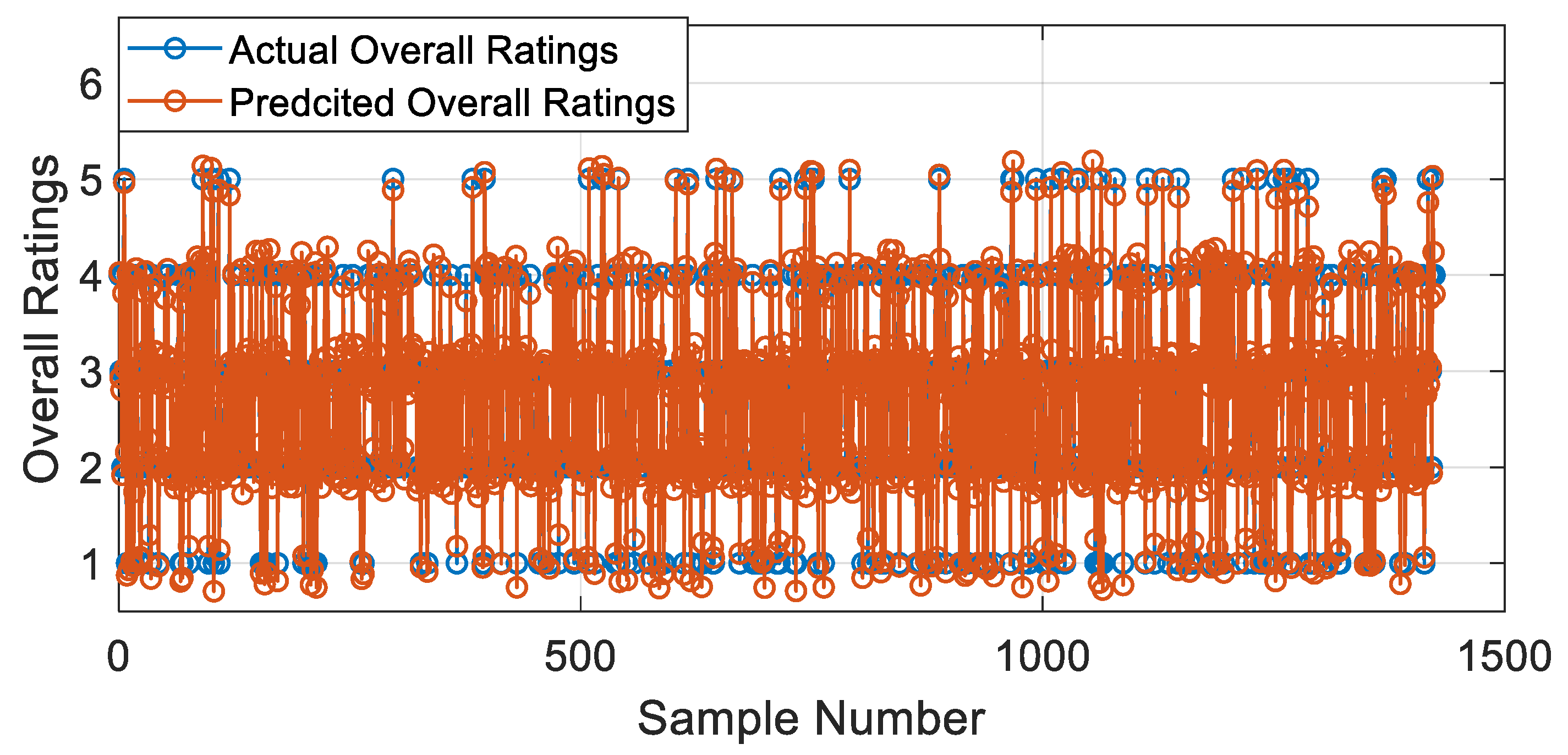
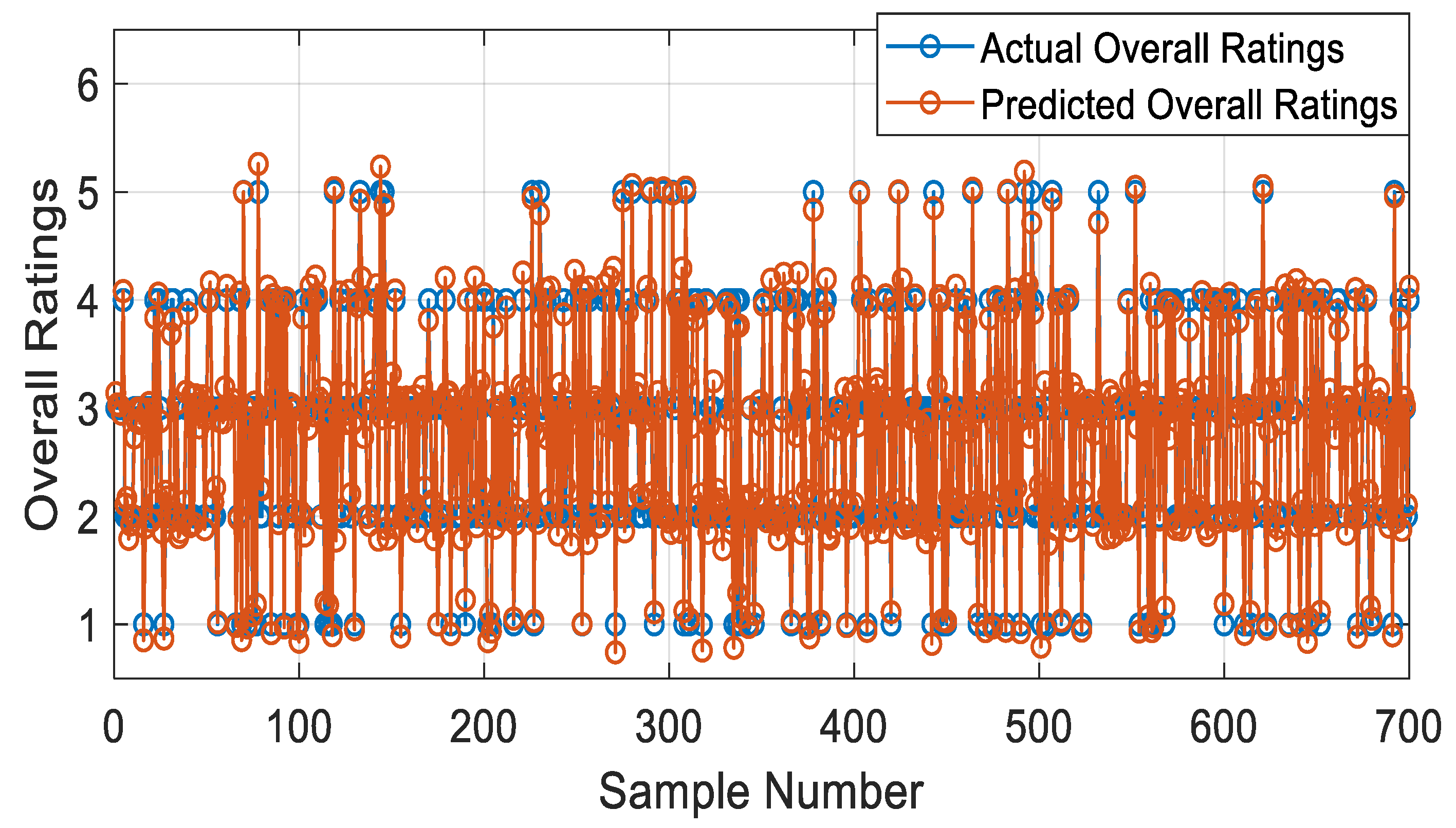
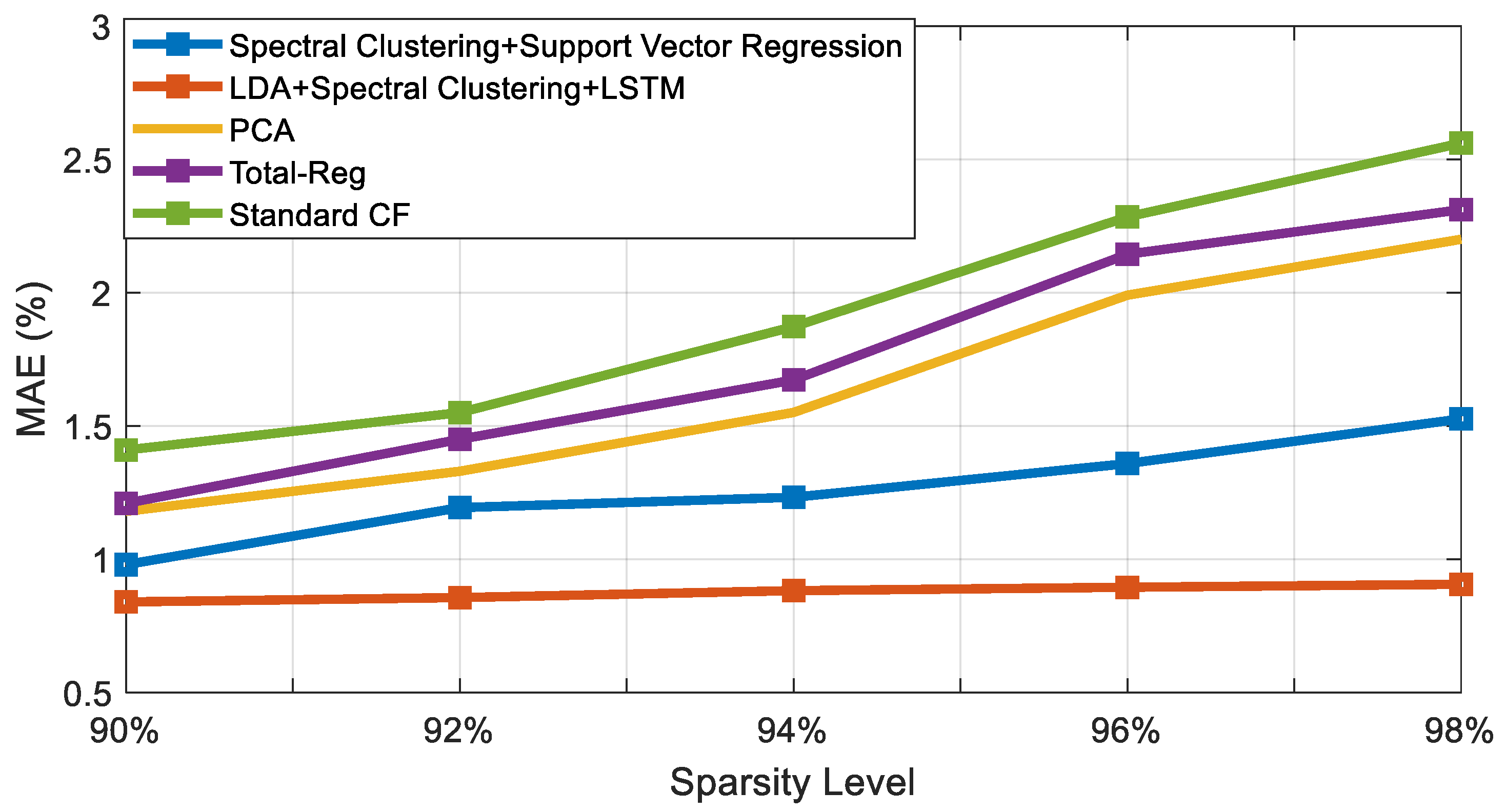
| Clusters | ||||
|---|---|---|---|---|
| Cluster 1 | Cluster 2 | Cluster 3 | Cluster 4 | |
| Mean | Mean | Mean | Mean | |
| Location | 3 | 4 | 4 | 4 |
| Rooms | 3.24396 | 3.48977 | 3.56548 | 3.79957 |
| Value | 3 | 3 | 3 | 4 |
| Cleanliness | 4 | 4 | 2 | 4 |
| Service | 3 | 4 | 4 | 4 |
| Sleep Quality | 3.74930 | 1.63483 | 3.81321 | 3.89688 |
| Aspects | Clusters | |||
|---|---|---|---|---|
| Cluster 1 | Cluster 2 | Cluster 3 | Cluster 4 | |
| Mean | Mean | Mean | Mean | |
| Green Spaces Aspect | 0.508162 | 0.508521 | 0.512453 | 0.501618 |
| Waste Management Aspect | 0.505902 | 0.502755 | 0.483136 | 0.506771 |
| Energy Efficiency Aspect | 0.49788 | 0.49391 | 0.48553 | 0.51057 |
| Green Spaces Aspect | Waste Management Aspect | Energy Efficiency Aspect | |||||||||||
|---|---|---|---|---|---|---|---|---|---|---|---|---|---|
| Clusters | Clusters | Clusters | |||||||||||
| Cluster 1 | Cluster 2 | Cluster 3 | Cluster 4 | Cluster 1 | Cluster 2 | Cluster 3 | Cluster 4 | Cluster 1 | Cluster 2 | Cluster 3 | Cluster 4 | ||
| Mean | Mean | Mean | Mean | Mean | Mean | Mean | Mean | Mean | Mean | Mean | Mean | ||
| Overall Ratings | 1.000 | 0.454 | 0.416 | 0.451 | 0.418 | 0.436 | 0.431 | 0.421 | 0.354 | 0.463 | 0.468 | 0.432 | 0.309 |
| 2.000 | 0.480 | 0.501 | 0.488 | 0.458 | 0.470 | 0.490 | 0.457 | 0.449 | 0.472 | 0.502 | 0.450 | 0.475 | |
| 3.000 | 0.511 | 0.510 | 0.524 | 0.500 | 0.529 | 0.483 | 0.465 | 0.508 | 0.492 | 0.488 | 0.492 | 0.511 | |
| 4.000 | 0.551 | 0.568 | 0.547 | 0.514 | 0.543 | 0.583 | 0.584 | 0.521 | 0.561 | 0.487 | 0.530 | 0.532 | |
| 5.000 | 0.692 | 0.526 | 0.570 | 0.531 | 0.626 | 0.605 | 0.591 | 0.551 | 0.605 | 0.585 | 0.630 | 0.517 | |
| Prediction Methods | RMSE | MAE | |
|---|---|---|---|
| Long Short-Term Memory | 0.99 | 0.82 | 0.98 |
| Support Vector Regression | 1.10 | 0.98 | 0.94 |
| Gaussian Process Regression | 1.12 | 0.99 | 0.91 |
| Artificial Neural Network Regression | 1.15 | 1.02 | 0.85 |
| Decision Tree Regression | 1.18 | 1.13 | 0.82 |
| Linear Regression | 1.20 | 1.09 | 0.80 |
| Stepwise Regression | 1.22 | 1.16 | 0.78 |
| Method | Precision at Top @5 | Precision at Top @7 | MAE |
|---|---|---|---|
| PCA [64] | 69.11 | 68.15 | 1.18 |
| Total-Reg [20] | 66.31 | 64.33 | 1.21 |
| Standard-CF [20] | 63.22 | 62.99 | 1.41 |
| Spectral Clustering + Stepwise Regression | 72.12 | 71.18 | 1.09 |
| Spectral Clustering + Gaussian Process Regression | 75.32 | 74.67 | 0.99 |
| Spectral Clustering + Linear Regression | 71.45 | 70.12 | 1.16 |
| Spectral Clustering + Artificial Neural Network Regression | 73.17 | 72.11 | 1.02 |
| Spectral Clustering + Decision Tree Regression | 72.85 | 71.99 | 1.13 |
| Spectral Clustering + Support Vector Regression | 77.44 | 75.75 | 0.98 |
| LDA + LSTM | 78.33 | 76.77 | 0.96 |
| LDA + Spectral Clustering + LSTM | 89.44 | 88.21 | 0.84 |
| LDA + LSTM | 4 Neighbor | 8 Neighbor | 12 Neighbor | 16 Neighbor | 20 Neighbor |
| Top-1 | 0.8857 | 0.8644 | 0.8236 | 0.7675 | 0.7491 |
| Top-20 | 0.8713 | 0.8317 | 0.7964 | 0.7393 | 0.7143 |
| Top-40 | 0.8344 | 0.7954 | 0.7448 | 0.7269 | 0.7082 |
| Top-60 | 0.8161 | 0.7855 | 0.7259 | 0.7068 | 0.6953 |
| Top-80 | 0.7912 | 0.7750 | 0.6969 | 0.6803 | 0.6591 |
| Top-100 | 0.7904 | 0.7629 | 0.6625 | 0.6492 | 0.6235 |
| LDA + Spectral Clustering + LSTM | 4 Neighbor | 8 Neighbor | 12 Neighbor | 16 Neighbor | 20 Neighbor |
| Top-1 | 0.9089 | 0.8876 | 0.8368 | 0.7907 | 0.7723 |
| Top-20 | 0.8945 | 0.8549 | 0.8096 | 0.7525 | 0.7245 |
| Top-40 | 0.8476 | 0.8186 | 0.7580 | 0.7401 | 0.7204 |
| Top-60 | 0.8293 | 0.7987 | 0.7391 | 0.7200 | 0.7185 |
| Top-80 | 0.8144 | 0.7822 | 0.7101 | 0.7035 | 0.6713 |
| Top-100 | 0.8036 | 0.7761 | 0.6757 | 0.6624 | 0.6367 |
Disclaimer/Publisher’s Note: The statements, opinions and data contained in all publications are solely those of the individual author(s) and contributor(s) and not of MDPI and/or the editor(s). MDPI and/or the editor(s) disclaim responsibility for any injury to people or property resulting from any ideas, methods, instructions or products referred to in the content. |
© 2025 by the author. Licensee MDPI, Basel, Switzerland. This article is an open access article distributed under the terms and conditions of the Creative Commons Attribution (CC BY) license (https://creativecommons.org/licenses/by/4.0/).
Share and Cite
Alghamdi, A. Leveraging Spectral Clustering and Long Short-Term Memory Techniques for Green Hotel Recommendations in Saudi Arabia. Sustainability 2025, 17, 2328. https://doi.org/10.3390/su17052328
Alghamdi A. Leveraging Spectral Clustering and Long Short-Term Memory Techniques for Green Hotel Recommendations in Saudi Arabia. Sustainability. 2025; 17(5):2328. https://doi.org/10.3390/su17052328
Chicago/Turabian StyleAlghamdi, Abdullah. 2025. "Leveraging Spectral Clustering and Long Short-Term Memory Techniques for Green Hotel Recommendations in Saudi Arabia" Sustainability 17, no. 5: 2328. https://doi.org/10.3390/su17052328
APA StyleAlghamdi, A. (2025). Leveraging Spectral Clustering and Long Short-Term Memory Techniques for Green Hotel Recommendations in Saudi Arabia. Sustainability, 17(5), 2328. https://doi.org/10.3390/su17052328





